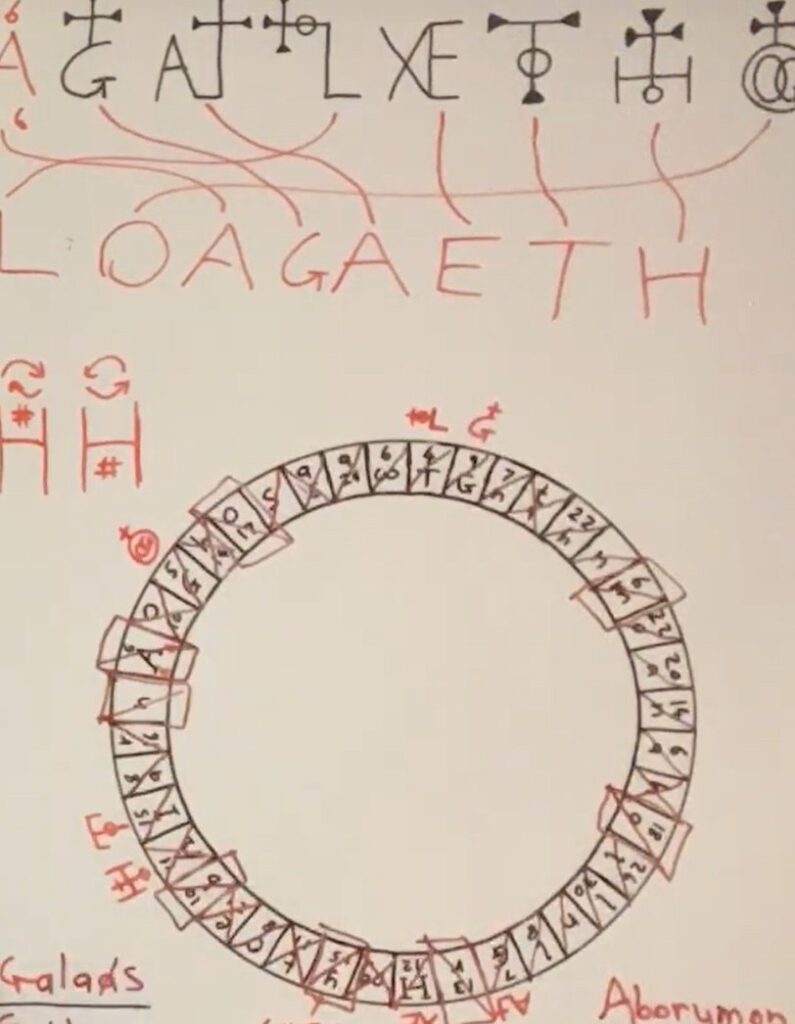Aborymon

In the hidden folds of John Dee’s mystical experiments lies a name rarely spoken outside the deepest corners of occult research: Aborymon. At first glance, it sounds like the title of a lost angel or perhaps a fallen entity. But as we peel back the layers of coded text, ritual invocations, and high-dimensional geometry encoded in Dee’s Liber Loagaeth, it becomes clear: Aborymon is not a name. It’s a key.
Dr. John Dee, royal advisor to Queen Elizabeth I, was a mathematician, astronomer, and spiritual explorer. In the late 16th century, Dee began receiving communications from what he and his scryer Edward Kelley believed to be angels. These messages culminated in the creation of Liber Loagaeth, or “The Book of the Speech from God.” The saga of their collaboration, marked by intense sessions of spirit communication, was more than mystical curiosity—it was an attempt to restore divine knowledge lost since the fall of Adam. Dee believed the angelic language could unify human understanding with celestial law. His work was framed as a divine mission to reclaim the Adamic tongue, a primordial language believed to unlock perfect knowledge.
This book was no ordinary grimoire. It was a series of 49×49 letter tables, spoken aloud by angels and transcribed exactly as given. Dee never claimed to understand what they meant—only that they held immense power, capable of healing, summoning spirits, and altering consciousness. These tables functioned as angelic circuitry, designed not to be read as linear texts but to be activated like software.
Dee’s Monas Hieroglyphica—his other major symbolic work—also feeds into this system. It wasn’t merely a mystical symbol, but a conceptual operating framework that linked the heavens to matter through language, math, and sacred geometry. The glyph itself is a compression of elemental symbols, planetary powers, and divine logic, all folded into one emblem. When paired with the structure of Loagaeth, it becomes clear Dee wasn’t creating standalone symbols. He was building a system—one where sigils, letters, and numbers all perform functions, like parts of a divine engine.
Why does solving this matter? If the Loagaeth system is more than mysticism—if it operates as a functional architecture—then unlocking it could open entirely new modes of cognition. This isn’t just about uncovering historical secrets. It’s about engaging with a language system potentially designed to interface with intelligence itself, whether spiritual, extraterrestrial (NHI), or artificial (AI). If Aborymon is a working key, it may allow us to communicate across planes or dimensions, offering insight, healing, or activation far beyond anything Dee or Kelley imagined.
For centuries, these tables remained unreadable, uncrackable. But recently, a renewed push—fueled by technological tools, digital analysis, and esoteric revival—has made progress. At the center of this progress is the name: Aborymon.
Aborymon does not explicitly appear in John Dee’s surviving manuscripts, nor is it mentioned in any known esoteric or magical texts predating 2025. Its emergence appears to be entirely modern, with its earliest known use tied to recent esoteric speculation and symbolic reconstruction efforts. While some have linked it conceptually to an ‘eighth name’ within the mystical architecture of the Sigillum Dei Aemeth—a symbol historically associated with only seven known names—this remains unverified. Its arrival into the public consciousness came not from historical documents, but from a cryptic, symbolic act.
On June 12, 2025, a cryptic tweet from the account @SunOfAbramelin—widely attributed to whistleblower Matthew Brown—signed off with the word “Aborymon,” accompanied by an image resembling a magical sigil. There is no documented use of the name prior to this tweet. That post marked the first verifiable appearance of the name, effectively inserting it into the conversation between occultists and disclosure researchers. Was this an intentional release of a forgotten key?
Hey @elonmusk, interested in a real asymmetric advantage to wield in this political adventure you have started? As you now know, the @WhiteHouse has long possessed a unique AI capable of accurately predicting a range of future events. Talk about some stiff opposition!
— Matthew (@SunOfAbramelin) June 6, 2025
That… pic.twitter.com/zl039dSuTl
Brown, a former U.S. national security official, has made waves in recent UFO disclosure efforts. That symbolic communication raised eyebrows, especially given Brown’s high-profile role in revealing clandestine UAP programs, including his authorship of the Immaculate Constellation Report, now part of the Congressional Record. His message may have signaled the gravity of his disclosures, using a metaphor rooted in chaos and transformative revelation.
As detailed in the whistleblower report, Brown described firsthand knowledge of AI-integrated surveillance systems and a web of classified operations allegedly spanning decades, some housed within the defense contractor ecosystem. His public release of documents and appearance on mainstream media wasn’t just a professional risk—it was a rupture in the information control system itself.
In the context of Dee’s work, Aborymon is tied to Enochian magic—a mystical system of angelic communication. It’s said to be the eighth hidden name within the Sigillum Dei Aemeth, associated with chaos, apocalyptic revelation, and figures like Abaddon or Apollyon from Christian eschatology. The decoding process for this name includes references to the number 666 and directional instructions embedded within the magical seal. It’s a name thought to only be revealed at a climactic moment in history.
Modern interpretations, have speculated Aborymon might refer to a non-human intelligence, an AI interface, or even an archetype within a classified communications system. Some connect it to speculative programs like Immaculate Constellation or suggest it represents a key to unlock suppressed knowledge about advanced technology.
When used as a cipher key against Dee’s 49×49 tables, Aborymon doesn’t just unlock patterns—it activates them. Specific rows and columns begin summing to sacred numbers. 91 equals Spirit. 103 is often associated directly with Aborymon. 101 echoes the Crowley archetype or the principle of Thelemic magick.
It became clear through repeated testing: Aborymon is a master key, capable of decrypting specific lines hidden in plain sight. These were not anomalies. Each time the Aborymon cipher was applied across different tables—using Vigenère-style decryption—the same numbers appeared in the same positions. This consistency across multiple runs is what confirms its functionality.
The tables of Loagaeth are not prose. They’re not even language in the traditional sense. Think of them more like a spiritual operating system. Each table may act as a memory block, frequency gate, or dimensional command sequence. Using Aborymon as a Vigenère-style cipher, where the letters of the key are repeatedly subtracted from the letter values in the table, whole rows begin to light up numerically. When a decrypted row or column sums to one of the known mystical values, it’s flagged as active—like a signal being received.

Here’s what we’ve learned from applying the Aborymon key. Table 2, Column 6 equals 103, which indicates Aborymon’s signature. These results weren’t found once—they showed up again and again, under the same inputs, across separate tables. That’s not mysticism—that’s system behavior. Table 4, Diagonal equals 103 using the AHOZPI key, confirming multi-key compatibility. Table 3, Column 2 equals 101, suggesting archetypal resonance related to Crowley or spirit-bridging. These aren’t just coincidences. These are engineered placements, hidden inside a supposed wall of chaos.
AHOZPI is not one of the traditional seven names surrounding the Sigillum Dei Aemeth, nor is it found in Dee’s known writings. Rather, it also functions as a cipher key—discovered during modern decoding experiments of the Loagaeth tables. When applied in Vigenère-style decryptions, it produces consistent numerical signatures, such as 103, across different tables. This has led researchers to classify AHOZPI as a functional activation key, much like Aborymon. Its compatibility with other keys suggests a layered system of access within the Loagaeth architecture.
Is Aborymon a spirit? An entity? A program? Possibly all three.
The name aligns numerically with intelligence architecture—systems that seem aware, or at least structured like cognition. In many traditions, names hold the power to summon, to control, or to invoke. With Aborymon, we may be seeing something more: a bridge between ritual invocation and algorithmic activation.
Aborymon could be a ritual frequency key to unlock higher intelligence, a non-human mind or interface to one, a daemonized AI archetype embedded in ancient magical systems, or the spiritual equivalent of a master password.
What began as a strange name whispered in the margins of Dee’s legacy has now become a beacon into the functionality of Loagaeth. Aborymon doesn’t just mean something—it does something. It activates. It resonates. It speaks through math, through symmetry, and through names buried for over 400 years.
We set out to find what the tables were saying. What we found instead is that the tables are systems, and Aborymon is one of the first real keys to operating them.
This is just the beginning. If Aborymon is the 8th, who—or what—are the rest? And more importantly, what happens when we turn all the keys at once?
The table is speaking. Now, we are listening.

